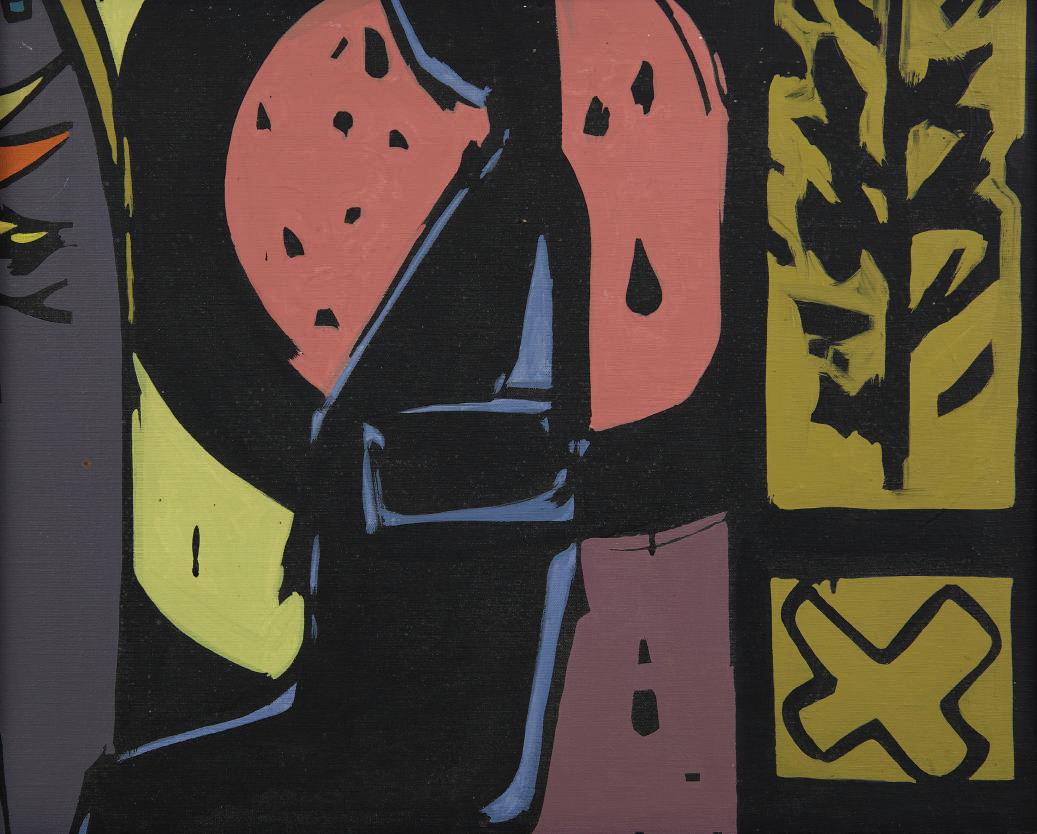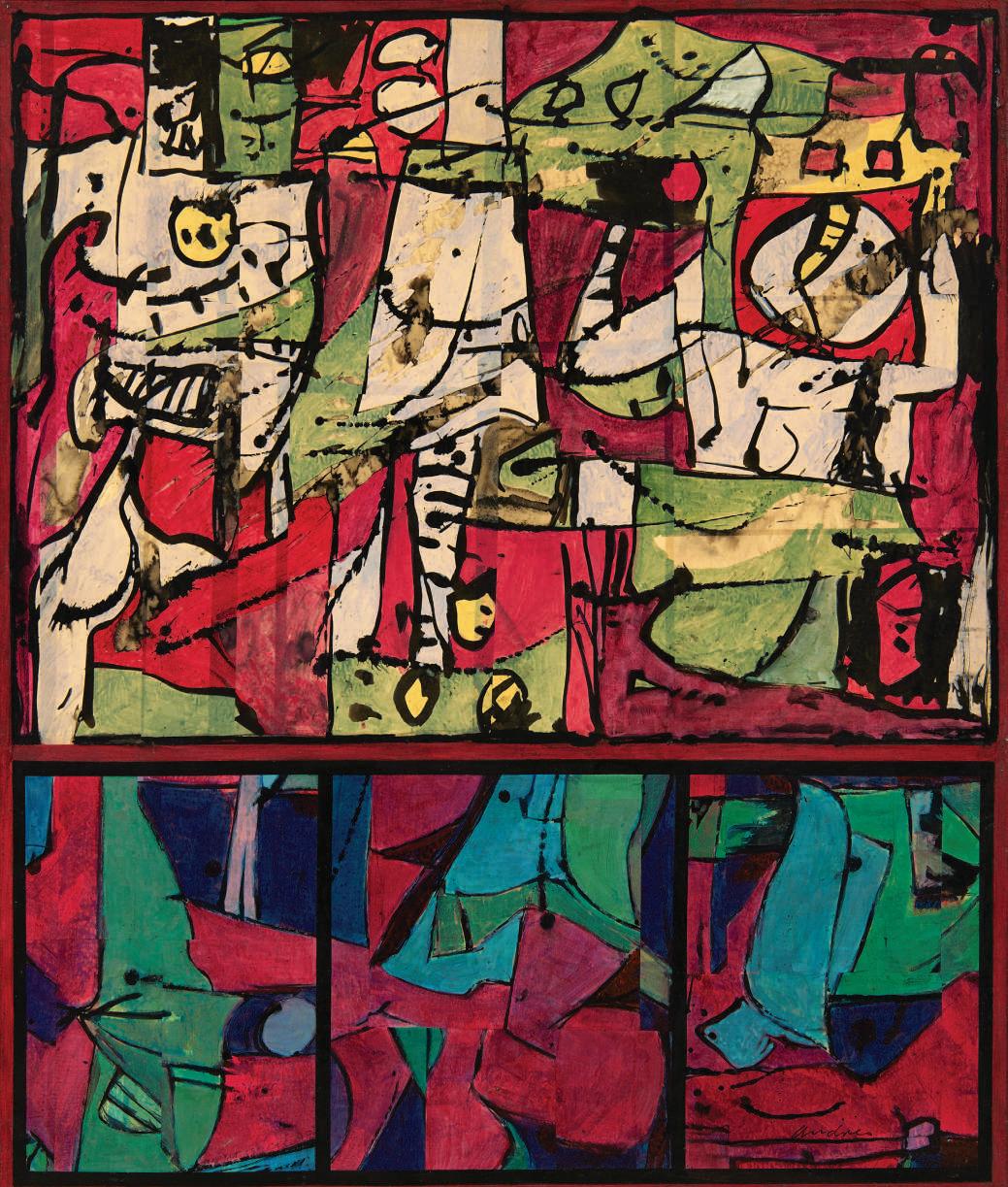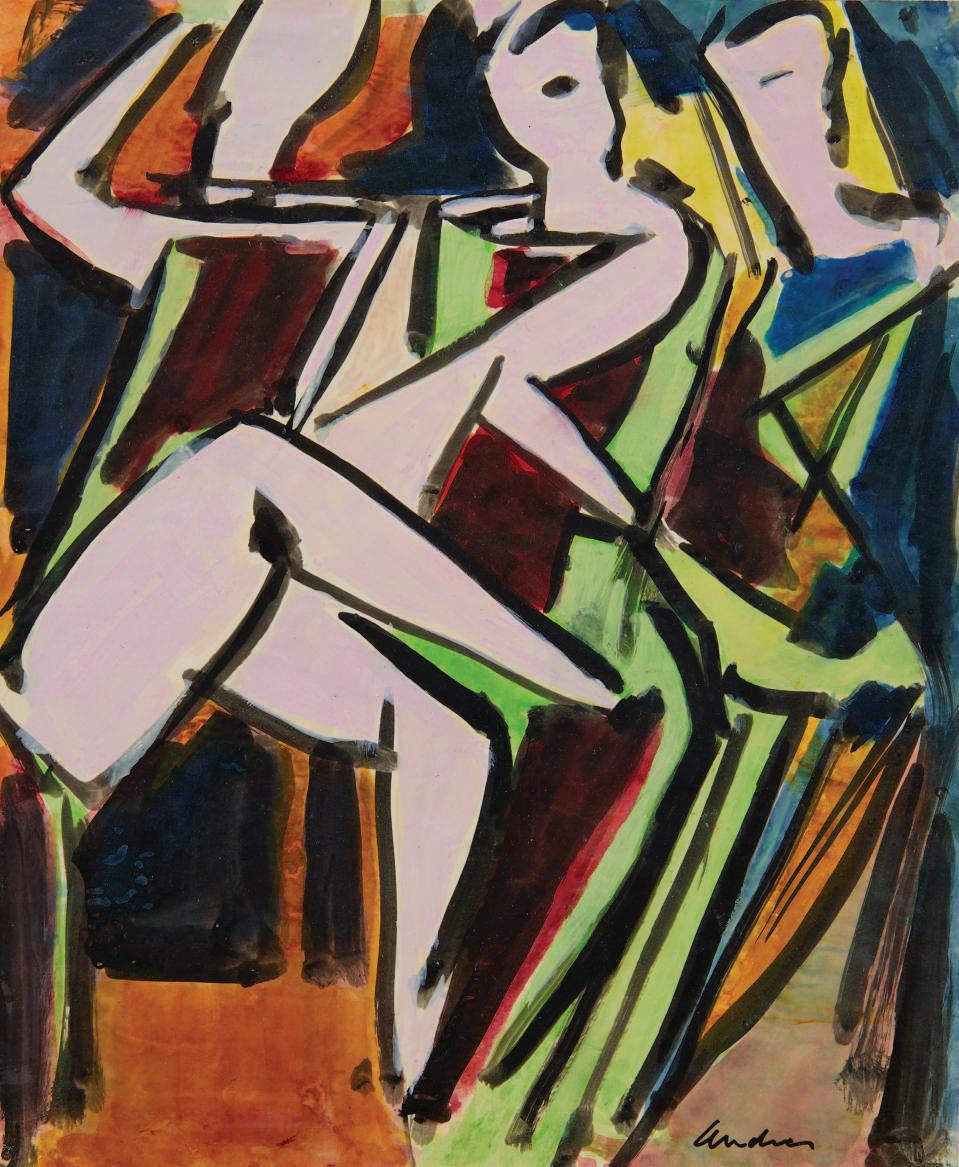

23645 Merchantile Road, Cleveland, OH 44122 info@wolfsgallery.com | 216-721-6945 wolfsgallery.com




23645 Merchantile Road, Cleveland, OH 44122 info@wolfsgallery.com | 216-721-6945 wolfsgallery.com

In June of 2022, WOLFS exhibited the first of the two large troves of Andres’ abstract expressionist work, offering an exciting introduction to this talented painter. And with this, our second exhibition, featuring lush, powerful and mature paintings done mostly after 1975, we are proud to present a complete and comprehensive examination of Richard Andres the artist.
After hanging the pictures for Andres 2.0, one clearly recognizes Andres’ hand, but surely with a different, more colorful story to tell. It is about this time Andres, like some of his contemporaries, began painting on large sheets of thin, translucent paper, then cutting and strategically applying the work to the larger canvas, apparently with great difficulty. The result is quite rewarding, creating large compositions with a magical, subtle, compartmentalizing of many smaller compositions within. Bathing these new pictures in a dazzling color palette, Andres has created a stunning body of work that offers the sensation of looking through stained glass windows or even a kaleidoscope as he guides us through each journey. Upon entering the exhibition, Andres’ colors excite, while the compelling compositions remain mysterious until one takes a closer examination. Here, faint lines reveal some of the secrets to the intriguing juxtaposition and overlapping, culminating in the success of Andres’ masterful works.
Andres 2.0 is a big statement. WOLFS is honored to present the work of Richard Andres.
We truly hope you enjoy the exhibition!













“He [Andres] finds new excitement in his work every day by painting abstraction in a paint-onpaper collage technique that he learned from COBRA painter Pierre Alechinsky. He’s equally at home in black and white, gentle hues and dazzling color (in stained-glass-like conformations). The format of his work substantially varies at different times.”
- Helen Cullinan, Art Critic Plain Dealer, February 2, 1990 “Abstract endures as his style”





The Challenge, c. 1982


72. The King of Diamonds Accepts Challenges, 1982 acrylic and ink on paper mounted on canvas, 47.5 x 47.5 inches
Exhibited: The Cleveland Institute of Art: 100 Years, Cleveland Museum of Art, 1983
“It is hard to talk about what you do when you never figure out what you are doing ahead of time,” he said. “I often start with a drawing and use it as a basis for something bigger. Sometimes the element is movement. I have always wanted to do something with speed and flow. Sometimes there is a figurative basis. Sometimes still life. Sometimes landscape.”
- Richard Andres Helen Cullinan, Art Critic Plain Dealer, February 2, 1990 “Abstract endures as his style”






77. Reflections, 1985 acrylic and ink on paper mounted on canvas, 52.5 x 72.5 inches



80. Pool, c. 1985
acrylic and ink on paper mounted on canvas, 49 x 48 inches
Exhibited: The Butler Institue of American Art’s 58th Area Artists Annual Exhibition

81. Magic Act, 1986 acrylic and ink on paper mounted on canvas, 41 x 71 inches

acrylic and ink on paper mounted on canvas, 60 x 70 inches


84. February, 1986
acrylic and ink on paper mounted on canvas, 50.5 x 71.5 inches


86. North Sea, 1987
acrylic and ink on paper mounted on canvas, 53.5 x 73.5 inches
Exhibited: Cleveland Museum of Art, May Show 1987






















Top: 107. Untitled, c. 1988 acrylic and ink on paper, 10 x 12.5 inches
Bottom: 108. Untitled, c. 1988 gouache and ink on paper, 18 x 24 inches

Richard and Avis, one man show, Canton Art Institute, 1980
Richard Andres was born in Buffalo, New York in 1927. A graduate of the Cleveland Institute of Art in 1949, he was immediately drafted and served for two years in the army as a mural painter. He received his Master of Arts from Kent State in 1961. A frequent exhibitor at galleries and museums and winner of multiple May Show prizes, Andres taught art in the Cleveland Public Schools for 28 years, as well as teaching the University of Buffalo, the Cleveland Institute of Art and the Western Reserve University.
Very little in Richard Andres’ childhood would have predicted his love of classical music, mid-century modern architecture and certainly not his lifelong passion for art and in particular abstract art. Richard’s father, Raymond, had no more than a third-grade education, and his mother, Clara, was one of thirteen children — only three of whom lived into adulthood and none of whom attended highschool.
They lived, when Richard was a boy, in a dingy area of Buffalo, NY in a walk-up apartment situated above a tavern. Raymond and Clara supplemented the income from their factory jobs in the bar downstairs with Raymond playing ragtime on the piano and Clara serving drinks. This often left Richard and his two older brothers at home alone to fend for themselves. The two older boys, Raymond and Russell, were — unlike Richard — rather rough and tumble and entertained themselves with stickball, boxing and the like. Richard, on the other hand, from a very young age liked to draw, or better yet even, to paint with the small set of watercolors he received for Christmas one year. Paper, however, at the height of the depression, was hard to come by. Luckily, Clara used paper doilies as decoration for the apartment and Richard would contentedly paint and then cut up doilies, gluing the pieces together to create collages.
Peter, Max and Mark Andres, Kent State University, 1961

At eight-years-old, he discovered the Albright-Knox Museum (then known as the Albright Art Gallery) and spent several hours a week there studying the paintings. He was particularly fond of Charles Burchfield‘s landscapes, enamored with their ‘messiness’ and thinking that they somehow captured more ‘feeling’ than works he was previously familiar with. For his tenth Christmas, he asked for and received a ‘how-to’ paint book by Elliot O’Hare. Through this self teaching, he assembled the portfolio needed for acceptance to Buffalo Technical High School where he studied Advertising Arts. In his Junior year, he was encouraged to enter a watercolor painting, “Two Barns,” in the national 1944-45 Ingersoll Art Award Contest and was one of twelve grand prize winners — each one winning one hundred dollars. More importantly the painting was exhibited at the Carnegie Institute Galleries, which resulted in his winning a national scholarship to the Cleveland School of Art (The Cleveland Art Institute).
He flourished at the art school under the tutelage of faculty members such as Carl Gaertner, as well as that of visiting artists such as William Sommer and Henry George Keller. He would say in later years that Gaertner, in particular, influenced his attitude toward life as well as art. “Gaertner,” Andres said, “believed that there was no need to be a ‘tortured artist’, that an artist should rather enjoy beauty, family, and life in general.” Free to spend his days as he chose, he wandered the Cleveland Art Museum for most of the hours he was not attending classes or painting; the remaining time was spent drinking coffee at a local hangout with art school friends — which is where he met fellow Henry Keller scholarship winner, Avis Johnson. Richard was immediately smitten with Avis, but being rather shy, it took him the entire summer
of 1948 to build up his courage to ask her out. Over that summer he ‘thought about Avis’ and worked in a diner to save money. He also used the hundred dollar prize money won in High School to visit the first Max Beckmann retrospective in the United States at the City Art Museum in St. Louis. Over a half century later he spoke of that exhibit with a reverence usually reserved for spiritual matters, “I walked in and it was like nothing I had ever seen before… the color.. It just glowed.”
Returning to campus in the Fall, the first thing he did was go to the coffee shop in hopes of finding Avis. He did, and she, upon seeing him, realized that she was also smitten with him. They quickly became known as ‘the couple’ on campus, and a year later, with Richard being drafted for the Korean war, they were quickly married by a Justice of the Peace, celebrating after with family at Avis’s Cleveland home. As a gift, faculty member John Paul Miller designed and made the simple gold wedding ring Avis wore for their 65 years of marriage. During those 65 years neither wavered in their mutual love, nor in the respect they shared for one anothers’ art.
The couple lived in a converted chicken coop in Missouri while Richard was in boot camp. At the camp, he would volunteer for any job offered and one of those jobs ended up being painting road signs. His commander noticed how quickly and neatly he worked and gave him more painting work to do - eventually recommending him for a position painting murals for Army offices in Panama. Until her dying day, Avis remained angry that “The army got to keep those fabulous murals and they probably didn’t even know how wonderful they were.” In Panama, their first son, Mark, was born. After Richard’s discharge in 1953, they moved back to the Cleveland area and used the GI bill to attend Kent State gaining his BA in education. The small family then moved briefly to Buffalo, where Richard taught at the Albright Art School and the University of Buffalo — and their second son, Peter, was born. Richard had exhibited work in the Cleveland May Show and the Butler Art Museum during his art school years, and during the years in Buffalo, his work was exhibited at the gallery he had so loved as a child, the Albright Art Gallery.
In 1956, the family moved back to the Cleveland area and Richard began teaching art at Lincoln West High
School during the day while working toward his MA in art at Kent State in the evenings. Avis and Richard, with the help of an architect, designed their first home - a saltbox style house in Hudson, Ohio, and in 1958, their third son, Max (after Max Beckmann) was born. Richard enjoyed the consistency of teaching highschool as well as the time it gave him to paint on the weekends and during the summer months. In 1961, he received his MA and his daughter, Claire, was born. With a fourth child, the house was much too small, and Avis and Richard began designing their second home. An admirer of MCM architecture, Richard’s favorite example of the style was the Farnsworth house – he often spoke of how the concepts behind this architectural style, particularly that of Mies van der Rohe, influenced his painting.
Andres described himself as a 1950’s painter, not fully accepting the designation of ‘Abstract Expressionist’ or ‘Abstract’ he saw his work as an extension of those styles, but rooted in the wider mid-century architectural concept of immersing the individual with nature, and the breakdown of the barrier between interior and exterior spaces. The house Avis and Richard built in 1967, with its open concept, and large glass curtainless windows reflected that concept, and the influence of living in that type of space can be seen in his later works. As Avis liked to say, “The idea is to have the walls be glass, but you need some real walls to have somewhere to hang paintings.”
In this house, Richard developed a style of painting that harkened back to his early years. In his studio, a room in the house with a large window, he would roll out large thin paper - the type used for architectural blueprints on the floor and paint on it. The large rolls of paintings would then be cut into pieces and then glued onto canvas, creating that ‘glow’ of color he admired in Beckmann’s exhibit. These paintings, often with titles such as “Windows” or “Gardens” have transparency that reflects the breaking of interior/ exterior boundaries of mid-century architecture as well as a joy realized in those early words of Carl Gaertner. In his late life Andres was fond of saying, “I am the wealthiest man in the world, look around, I have everything anybody could want. Look at my wife, my house, and all this art.”
Kent State University, M.A. (Art) 1961
Kent State University, B.S. Ed., 1954, Magna Cum Laude
U.S. Army, March 1951 to March 1953
Cleveland Institute of Art, B.F.A., 1950
Buffalo Technical High School, 1945, Honors
The Cleveland Public Schools, 1955-1983
The Albright Art School of the University of Buffalo, 1954-1955
Classes at the Cleveland Institute of Art, Western Reserve University and Western Reserve Academy
Kaleidoscope, Akron, Ohio
First Place, Acrylic, 2004
Honorable Mention, 2005
Cleveland Museum of Art - May Shows
Special Jury Mention - 1967, 1968, 1974, 1979, 1981, 1984
Ohio State Fair, Columbus, Ohio
Fine Arts Exhibition - 1982
Canton Art Institute, All Ohio Shows
Second Prize, Painting - 1979
Honorable Mention, Painting - 1977
Canton Art Institute, Fall Shows
Honorable Mention, Oil - 1969
Best in Show, Oil - 1968
Honorable Mention, Water Color - 1968
Honorable Mention, Water Color - 1967
Honorable Mention, Oil, Water Color, Drawing - 1965 Best in Show - 1961
Honorable Mention, Prints - 1961
Massillon Museum Purchase Award - 1969
Canton Jewish Community Center Best in Show - 1967
Chesterfield Purchase Award - 1967
Honorable Mention, Graphics - 1960
Akron Art Institute, Spring Shows
Two Honor Awards - 1966
Three Honor Awards - 1965
Kent State University, Independent Student Show
Purchase Prize, Oil - 1953
Third Prize, Drawing - 1953
Cleveland Institute of Art
Henry G. Keller Award for Excellence in Drawing - 1949
Cleveland Institute of Art, Student Independent Shows
First Prize - 1948
Second Prize - 1947
National Scholastic Scholarship Award, 1945
Ingersol Award - 1945
*RichardAndres:SelectWorks1950-1975, WOLFS Gallery, Cleveland, Ohio, 2022
12thAnnualJuriedExhibitionDoubleExposure, Pleiades Gallery, New York, NY - 1994
**Avante Gallery, Cleveland - 1990
Andres–AFamilyShow, The Cain Park Art Gallery, Cleveland Heights - 1986
Cleveland Museum of Art MayShows - 1947-1954, 1956, 1957, 1959-1961, 1964, 1967-1977, 1979, 1981, 1983, 1984
Cleveland Museum of Art, The Cleveland Institute of Art 100 Years - 1982
Erie Fine Art Center, SpringShow - 1982
Canton Art Institute, All Ohio - 1977, 1979, 1981
Beck Center, Lakewood, Ohio, WorkbytheAndresFamily - 1981
Canton Art Institute, TheAndresFamilyShow - 1980
** Staircase Gallery, Hudson, Ohio - 1976
Blossom Music Center - 1976
** Dobama Theater, Cleveland, 1972, 1974
* Cleveland Institute of Art, DistinguishedAlumnus - 1974
Cleveland Institute of Art Alumni Invitational - 1973
Kent State Alumni Invitational - 1973
Arts International, Cleveland - 1971
CuyahogaCommunityCollegeInvitational - 1970
Akron Area Artists Invitational, Massillon Museum - 1970
ClevelandMuseumofArtTravelingShows - 1947-1951, 1960-1961, 1966-1969
* Intown Club, Cleveland - 1967
* Maione College, Canton - 1966
Akron Art Institute - 1965, 1966
* Canton Art Institute - 1964
ContemporaryAmericanWaterColorInvitational, Grand Rapids, Michigan - 1963
*Kent State University - 1961
Cleveland Institute of Art FacultyShows - 1956-1958
Albright Art Gallery, 21st Western N.Y. Exhibition - 1955
AlbrightArtSchoolFacultyExhibit, Albright Art Gallery, Buffalo - 1954
Butler Art Institute, New York Show, Youngstown, Ohio - 1950
**Karamu Theater, Cleveland - 1950
*0ne Man Shows
**Two Person Shows
Cleveland Museum of Art
Massillon Art Museum
ARTneo: The Museum of Northeast Ohio Art
Kent State University
Western Reserve Academy
Central National Bank of Cleveland
Cleveland Trust Company
U.S. Time Corporation
Ferro Corporation
The Chesterfield of Cleveland
Samuel Moore & Company - Eaton Corporation
Hiram College
The Andres family
Professor Henry Adams, Ruth Coulter Heede Professor of Art History at Case Western Reserve University
WOLFS staff:
Megan Arner
Arianne Flick
Kristen Newell
Christopher Richards, Context Fine Art
Clara Wolverton, Cerulean Conservation, LLC
Matthew Nunes, Videographer
Art Etc. Picture Framing
To all those, anonymous and otherwise, who have selflessly contributed to this worthy endeavor – thank you.

Claire Andres, 1962
“There are people who do art, but [Andres] was an artist in his being. His entire persona was that…”
- Claire Andres
